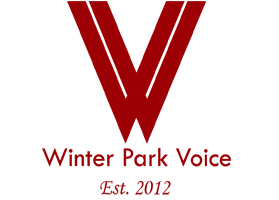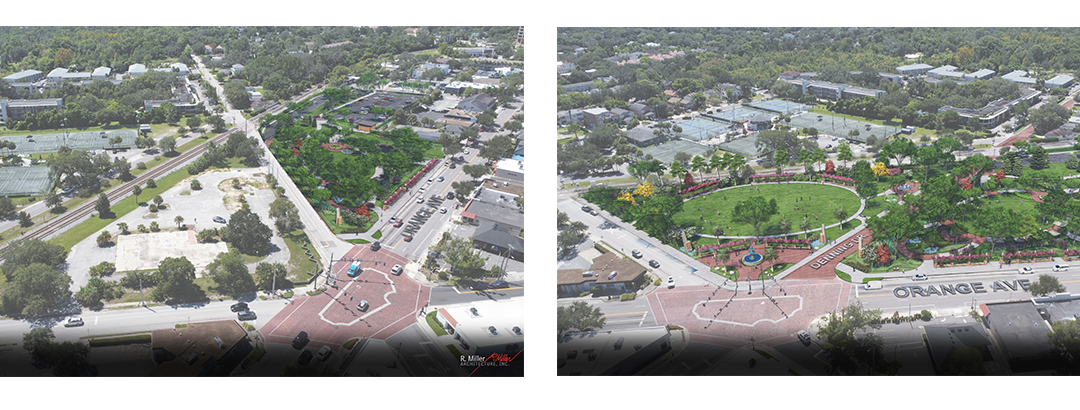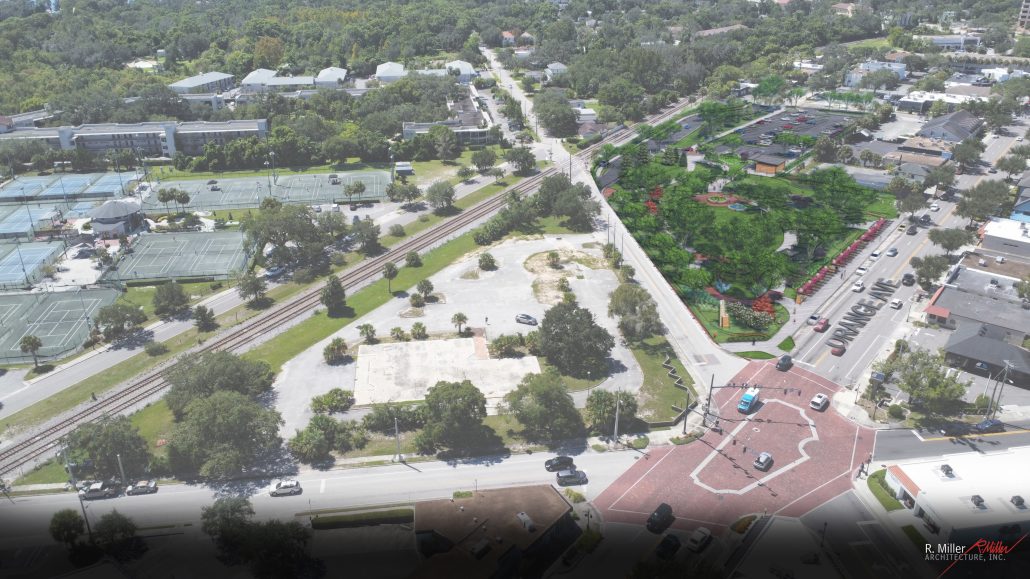New renderings show glimpse of Winter Park's future
The side-by-side comparison shows what the major corridor would look like with new park space vs. the pad of a building and parking lot
Sept. 9, 2023
By Beth Kassab
A new set of renderings commissioned by the Winter Park Land Trust juxtaposes two potential futures of a stretch of the city’s busy business corridor. One image shows a bank-owned parcel converted to green space to enlarge Seven Oaks Park. The other shows the pad of a commercial building and surrounding parking lot.
For advocates of preserving and growing green space amid an increasingly urban region, the choice could not be more clear.
“What’s right for the city residents 10 years from now, 30 years from now, 50 years from now – when many of us will be gone – is at stake here,” said Brad Blum, a Winter Park resident who served as chief executive officer of multiple major restaurant brands such as Olive Garden and Brio and is a member of the Winter Park Land Trust board. “The city has an important decision to make. An expanded and robust green space or a multi-story commercial building that will divide its current and limited green spaces.”
The Land Trust has pledged at least $500,000 to help the city purchase the parcel owned by the Arkansas-based Bank OZK (formerly known as Bank of the Ozarks) to enlarge Seven Oaks Park at the corner of Orange Avenue and Denning Drive. The total purchase price is about $6 million. The sale to the city is part of a deal in which the bank would build a branch at the mixed-use Ravaudage development instead.
In addition to a $1 million private contribution from sources including the Land Trust, the city has about $1 million in its parks acquisition fund. That leaves about $4 million that must be financed by the city in order to get the deal done, according to a budget memorandum by city staff that expressed some concern about the feasibility of the plan.
“Staff estimates that the city could borrow at a rate of about 4.5%, and over 15 years that would approximate $372k in annual debt service payments,” the memo says. “While this number is within the General Fund’s current contingency balance estimated for FY24, it may be difficult to sustain over the longer term as revenue growth rates dim and expenditures driven by pension, healthcare, and lingering inflation costs, put pressure on budgets.”
Staff noted that debt service payments could increase to more than $500,000 per year if the cost of improving the land is also financed. It’s possible though, staff pointed out, that city commissioners could opt to pay for the purchase out of the general fund’s reserve dollars or sell other assets such as the old Winter Park Library or other land to generate money for the expanded park.
Questions or comments? Email the editor at WinterParkVoiceEditor@gmail.com





Postage Stamp Park is very nice but the area really needs Bank of Ozarks property as well to make it look like a REAL park.
“some concerns about the feasibility of the plan”?
$6 million upfront, $560,000 a year to purchase and maintain a 2 acre park that will have no attraction for residents, seems ridiculous to me. A drive-by park. WP Land Trust has wealthy members. Why should the WP taxpayer fund $4 million of their $6 million dream park? And then $560,000 a year for maintenance and debt service? The trust should buy it outright and pay for yearly upkeep.
Give them a plaque acknowledging their generosity. I’ll gladly make a donation to the plaque.
Six million dollars sounds like a lot of money but really it is only $200 per resident.
For a park that will be around a hundred years at least that’s only $2 per year per resident or half a cent per day per resident.
Pitt, I know you don’t like it when the City buys parks but when you have a fit over a purchase that amounts to only half a penny a day per resident some of us are are wondering if what you really need is to relax a little more on your days off and enjoy life.
I like it when people activate a park. Seven Oaks Park (Progress Point) was originally to be paid for by the developer of the land on the RR tracks under the OAO agreement. The commission could’ve negotiated more open space (and stormwater repairs, and traffic upgrades) than they now have for Seven Oaks. They preferred to make it a city expense rather than a free asset. Now we have no people, a passive park planned for the corner and another passive park next door. Again, why not negotiate with a developer to build on Ozarks and require open space, stormwater improvements, traffic improvements? The commission is giving the taxpayers the bill for all of this in exchange for an open space next to railroad tracks. Not my 1st choice. If the city wants to borrow money for a park, let’s have a referendum. WP golf course is an $8,000,000 debt. This would be a $4,000,000 debt. And we likely wouldn’t have to hire a $150,000 project engineer to handle the infrastructure improvements that should be paid for by developers. Oh well!
If these city commissioners want this project; they can pay for it.
We can have a fund raiser for the “plague “.
These people like to spend other people’s money.
We don’t need to be spending more money on the library. The library is a local “jobs program” program. It looks like it is 30 years old.
Ah.
EXACTLY what Postage Stamp Park needs!
An ENVELOPE to stick it on.
Everyone PLEASE read and reread Pitt’s data. Ler’s spend the money to make life better for those of us still around. Commissioner’s won’t increase the millage to pay for basic necessities even though it would only be a couple hundred dollars per household for millions of dollars to fix things NOW rather in 10-15 years. The added debt is NOT a gift for the future commissioners and city residents.
Hi, why doesn’t the City of Winter Park lease the location where the Bank of the Ozarks was once to some business-like bar/food so that way Winter Park can generate money? Btw, this is my first time post here. I don’t get the concept of paying extra $ that there is no guarantee people will go there for leisure time and not generating money.
I think the park renderings look fantastic.
I tend to support green space. But Pitt has a good point regarding whether or not people would use the additional park space. So my questions are, what needs to surround the park to bring people in and what needs to be inside the park to draw the community?
There is a significant positive impact of park land on the value of surrounding real estate. Studies have shown that parks have an 8% to 20% higher valuation than other properties. This is because parks provide a number of benefits including:
Increased property value: This is because parks are seen as desirable amenities that add to the quality of life in a community.
Increased property tax revenue: When property values increase, so does the amount of property tax revenue that the city collects.
Increased property sales: Properties near parks tend to sell more quickly than others. This is because buyers are more likely to be interested in homes that are located near parks. Look at Central Park.
Increased property investment: Properties near parks are more likely to invest in their properties.
Increased property appreciation: Properties near parks tend to appreciate in value at a faster rate than other properties. This is because parks are seen as long-term assets that will continue to add value to the community.
In an area of needed redevelopment, a centralized park will benefit commercial and mixed-use properties to include:
Increased foot traffic: Parks attract people to the area, which can lead to increased foot traffic for businesses located nearby.
Improved visibility: Parks can improve the visibility of businesses by providing a backdrop or setting for them.
Enhanced curb appeal: Parks can add to the curb appeal of a neighborhood, which can make it more attractive to businesses and customers.
Increased property values: Commercial properties near parks can command a higher price than similar properties that are not near parks.
To the “activate” people, did you ever think of what Winter Park would be like if previous City Commissions had conditioned each park approval on how much “activation” it would create?
Who came up with this activation nonsense?
The whole point of a PARK is that it is NOT active.
That’s what makes it a PARK.
it’s GREEN SPACE.
Do you want to ACTIVATE a cloud in the sky?
How about all the empty seats in your car when you drive through town by yourself?
Want to activate them?
How about anywhere there is an empty space in your house?
Head down to the store to buy something to put there?
LOL
Please share with us the WP parks that you visit that are not active. I can’t think of one that has a taxpayer visiting it.
A couple examples of passive parks:
Kraft Azalea Garden is a very popular passive park.
Central Park on Park Avenue is a great example of a passive park that “activates” the surrounding shops and restaurants.
Pitt – i suggest that you visit Lake Knowles. Passive use only, but actively visited throughout the day.
Yes! A 9 acre lake that is accessible to hundreds of people within a 5-10 minute walk. Walking, running, biking, strolling, fishing, feeding Muscovy …scratch that, feeding native waterfowl. And just sitting on a bench contemplating the lake and life in this little burg that is better than 99.99% of the little cities in the world. I call that an active park.
Bravo, I support the park expansion.
This is a vastly different make-up of leaders who are making positive strides for residents.
Grumpies like you Pitt are boring.